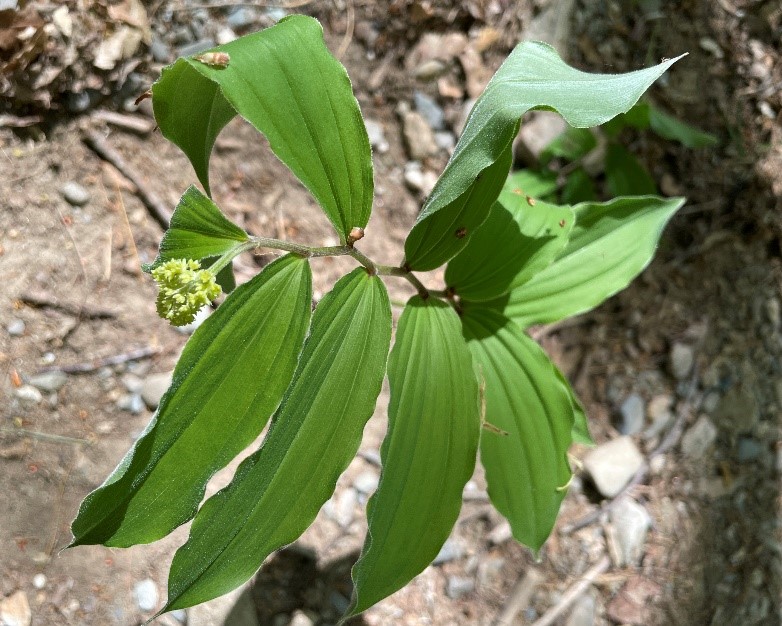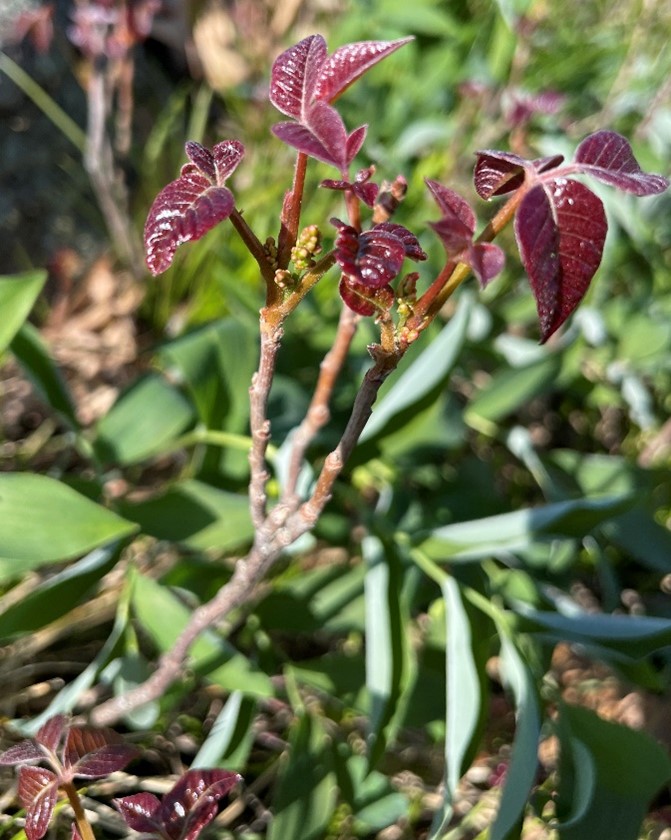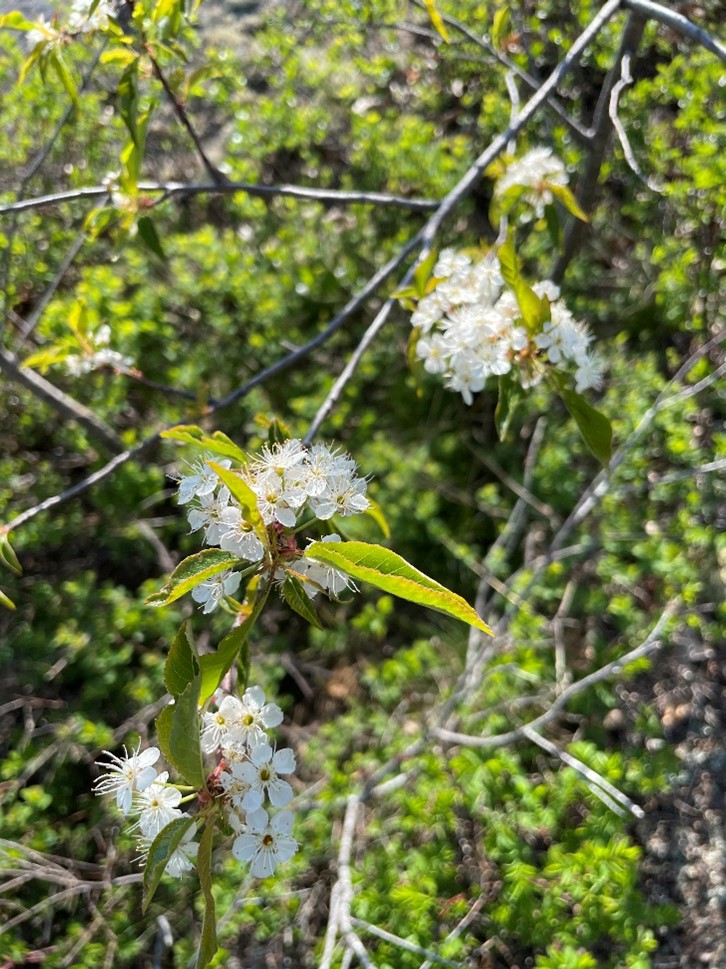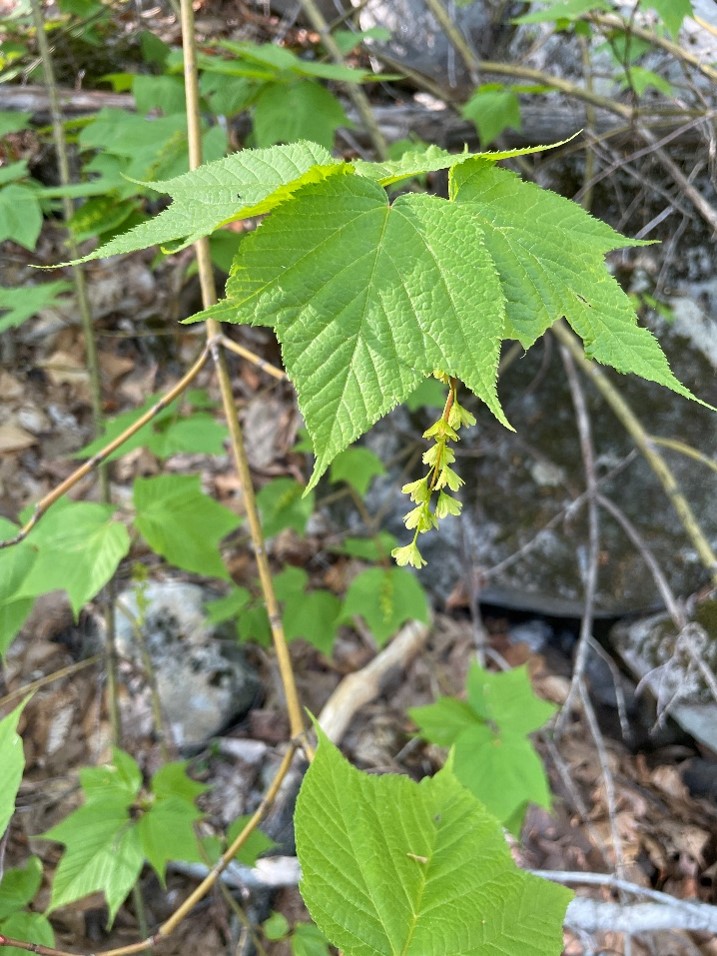By Roger Rittmaster
May 19, 2023
The Maiden Cliff Trail is perhaps the most popular hiking trail in the Camden area. Most people hike the 556 ft elevation climb to the Maiden Cliff Lookout and turn around, but in doing so, they miss the spectacular views and rocky outcrops on the ridge above (another 137 ft elevation gain). On May 14 my wife and I hiked the loop trail counterclockwise, traced in black on the map below. This loop is a combination of three trails: the Maiden Cliff Trail between the trailhead (TH) to the start of the loop, the Ridge Trail going counterclockwise up to the ridge, the Scenic Trail along the top of the ridge back down to the Maiden Cliff Lookout, and the Maiden Cliff Trail back to the trailhead. We wanted to see how many spring wildflowers we could find in this acidic mixed forest dominated by red oak and hemlock, typical of many of the mountain trails in the Mid-Coast. If you are familiar with iNaturalist and want to see the location of the photographs, follow this link to the collection.
A word of warning: there are some moderately steep climbs and descents on this hike.

Here’s the list of the flowers we saw on the trail that were either blooming or about to bloom. Photos of the plants with brief descriptions follow.
- Common Blue Violet (Viola sororia)
- Cypress Spurge (Euphorbia cyparissias)
- Wintercress (Barbarea vulgaris)
- Solomon’s Plume or False Solomon’s-Seal (Maianthemum racemosum)
- Hairy Solomon’s-Seal (Polygonatum pubescens)
- Canada Mayflower ( Maianthemum canadense)
- Sessile Bellwort (Uvularia sessilifolia)
- Clintonia (Clintonia borealis)
- Hobblebush (Viburnum lantanoides)
- Pink Lady’s Slipper (Cypripedium acaule)
- Low-bush Blueberry (Vaccinium angustifolium)
- Bearberry (Arctostaphylos uva-ursi)
- Pink Corydalis (Capnoides sempervirens
- Wild Sarsaparilla (Aralia nudicaulis)
- Poison Ivy (Toxicodendron radicans)
- Pin or Fire Cherry (Prunus pennsylvanica)
- Red Elderberry (Sambucus racemosa)
- Red Trillium (Trillium erectum)
- Virginia or Early Saxifrage (Micranthes virginiensis)
- Red Columbine (Aquilegia canadensis)
- Striped Maple (Acer pensylvanicum)

This patch of Common Blue Violet (Viola sororia) was located just to the left of the start of the trail. It prefers rich, moist woods, which is why it was only seen here and not on the acidic, rocky slopes. It does seed easily in cultivated areas, including lawns. The seed coating is eaten by ants, which then discard the fertile core, propagating the species. Violets are the host plants for fritillary butterflies, such as the common Great Spangled Fritillary.

Cypress Spurge (Euphorbia cyparissias) was the first wildflower we encountered, covering much of the steep slope between the parking lot and Route 52. This yellow-flowered plant is a nasty invasive from Europe with milky sap that can cause skin irritation and an allergic reaction. Don’t touch it without gloves!

A small patch of Wintercress (Barbarea vulgaris), also called Garden Yellow-Rocket, was located in front of some rocks near the entrance to the trail. Wintercress is in the mustard family and each flower has 4 petals, typical of this family. It is another invasive from Europe and can take over a field or roadside. On the plus side, the leaves are edible when young.
OK, I agree, these last two plants shouldn’t be called “Spring Wildflowers”, which to me implies “native”, but I wanted to include them for completeness.

Almost immediately after starting on the trail, two classic, shade-loving, Spring wildflowers can be found. The first, Solomon’s Plume or False Solomon’s-Seal (Maianthemum racemosum), used to have a different genus name and used to be in the Lily family. It is now included in Asparagaceae (Asparagus family). Thankfully, the common names don’t change! False Solomon-Seal can be distinguished from “true” Solomon’s-Seal by the elongated cluster (raceme) of flowers at the tip of the stem. In this photo, the raceme has not yet elongated.

Mixed in with False Solomon’s-Seal was at least one Hairy Solomon’s-Seal (Polygonatum pubescens), one of the “true” Solomon’s Seals, also in the Asparagus Family. The leaves and overall plant look similar to False Solomon’s Seal, but the flowers are located at the base of the leaves, often in pairs. Both species have leaves with parallel veins, typical of species in the former Lily family. Later in the season the flowers turn into green, then purple, berries. Although the young shoots of Solomon’s Seals are edible, the mature leaves and berries are poisonous, causing vomiting and diarrhea.

While we’re in the Asparagus family, we don’t want to overlook Canada Mayflower or False Lily-of-the-Valley, Maianthemum canadense, in the same genus as False Solomon’s-Seal. This often-diminutive plant was present in many locations on the forest floor along the trail. It was not yet in bloom but will be by the time you read these words. Canada Mayflower has just two leaves and a central raceme of flowers whose berries turn from green to golden to reddish-purple later in the season.

Another member of the former Lily family on the Maiden Cliff Trail is Sessile Bellwort (Uvularia sessilifolia, Wild Oats), now in the Colchicaceae (Bellwort family). Bellworts are characterized, in part, by long tubular flowers. The term “sessile” refers to the lack of a stem on the leaves. Sessile Bellworts are the first of the lily-like flowers to bloom in the Spring and can be found on many Coastal Mountains Land Trust trails. Many plants do not produce flowers and reproduce asexually by underground roots.

The final member of the former Lily family in bloom on the Maiden Cliff Trail is Clintonia (Clintonia borealis, Bluebead Lily). It has remained in the Lily family (Liliaceae). Clintonia generally grows in dense colonies in the shade, and this large group can be found on the uphill side of the lower trail leading to Maiden Cliff. In the absence of flowers, the glabrous (non-hairy) leaves can be mistaken for Pink Lady’s Slipper, but Clintonia usually has three basal leaves (two in young plants), whereas Lady’s Slipper has two leaves covered with small hairs (see below).

Within a 100 yards or so of the start of the trail, deep in the ravine along the stream, is the shrub, Hobblebush (Viburnum lantanoides, Moosewood). It is the earliest of our native Viburnums to bloom. The large outer flowers are sterile, while the fertile inner flowers produce edible fruits which turn from red to black when ripe. Viburnums have opposite leaves and can be distinguished from similar looking Dogwoods by the leaf veins which go straight to the leaf edge. On Dogwoods, the veins curve towards the leaf tip as they approach the edge.

Pink Lady’s Slipper (Cypripedium acaule), a member of the Orchid family, blooms in June, but its leaves were already fully developed. Its pink bulbous flowers are designed to fool insects which enter a gap between the two petals of the flower. Once inside, the insects can only escape by passing by the anthers at the base of the flower and being covered with pollen. To germinate, their tiny, wind-borne seeds must land in acidic soil and have a symbiotic fungus present, without which the seedlings will not germinate or grow. Lady’s Slippers do not bloom every year, and sometimes individual plants will remain dormant for an entire season.

As we approached the top of the mountain, low-bush blueberries (Vaccinium angustifolium) were in peak flower. A member of the Heath family (Ericaceae), it prefers the sunny, well-drained, acidic soil typical of montane landscapes of Maine. It also thrives in burned areas, which is why blueberry farmers typically burn their fields to enhance blueberry growth and suppress competition from other plants. Many moth and butterfly caterpillars feed on its flowers and leaves, including the diminutive Brown Elfin butterfly, which only flies during the first two weeks of May.

Bearberry (Arctostaphylos uva-ursi) is another member of the Heath family. It thrives on barren, rocky soils and is found on mountain outcrops. It is a low spreading shrub, with evergreen leaves that are similar to those of blueberries. The pale pink, urn-shaped flowers have a distinctive flare at their tip, making them easy to distinguish when they are blooming. They produce a red berry in late summer that lasts through the winter if not eaten.

Pink Corydalis (Capnoides sempervirens) is another plant that loves gravelly soil on rocky outcrops. It is also commonly found growing in barren soil after fires. Its tubular flowers are distinctive and photogenic. A member of the Poppy family (Papaveraceae), it typically flowers in May and June. We only found one Pink Corydalis on our hike, on the Scenic Trail near the highest point of the loop.

Wild Sarsaparilla (Aralia nudicaulis), a member of the Ginseng Family (Araliaceae), is common in many parts of our northern forest. Although it appears to have many leaves, each plant has only one leaf, which is divided into three leaflets and sub-divided into 5-6 more leaflets. The flowers arise on a separate leafless stalk containing 3 globe-shaped umbels of white flowers that turn into black berries by late summer. At first the leaves have a bronze cast, which soon turns green. Wild Sarsaparilla is sometimes mistaken for Poison Ivy (next paragraph) because of its early bronze coloration and leaflets which are often in groups of three. However, the shape of the plant, its separate flower stalk, and its lack of a woody base above ground make this an easy distinction for the careful observer.

There is an abundance of Poison Ivy (Toxicodendron radicans), a member of the Cashew Family (Anacardiaceae), near the summit of the Scenic Trail. It can be recognized by its woody stem and leaves divided into 3 leaflets with smooth edges (as opposed to the toothed edges of Wild Sarsaparilla leaflets). Often missed are the clusters of tiny white flowers at the base of the leaves that are not quite in bloom in this photo. Poison Ivy can grow in a variety of soil types and prefers sunny locations. Its well-known skin toxicity is due to urushiol which causes a contact dermatitis, with or without an allergic/anaphylactic response, in sensitive individuals.

Pin Cherry (Prunus pennsylvanica, Fire Cherry) is a small tree currently blooming among the rocky outcrops on the upper portion of the loop trail. It can look similar to Serviceberry (Amelanchier spp.), both of which bloom early in the season with 5-petaled white flowers, and both have toothed leaves. When in flower, Pin Cherry’s rounded petals can be easily distinguished from the elongated Serviceberry petals. Pin Cherry produces small, bright-red berries by July. Both Pin Cherry and Serviceberry belong to the Rose Family (Rosaceae).

Heading down from the Maiden Cliff lookout, there are a variety of photogenic wildflowers. On the uphill side of the trail, shortly after leaving the lookout is a small, out-of-place, Red Elderberry shrub (Sambucus racemosa) in flower. Red Elderberry prefers sunny locations, which is probably why this one is small with only one flower cluster. Red Elderberry produces bright red berries, often by the end of May or early June. Elderberries are a shrub that can be identified by their opposite, compound leaves, in addition to their cluster of white flowers and tiny berries. They belong to the Viburnaceae (Viburnum or Elder) family.

A couple of patches of beautiful Red Trillium (Trillium erectum, Stinking Benjamin) can be found on the downhill side of the trail between Maiden Cliff and the start of the loop. It is easiest to spot these plants by looking for the large 3-parted leaf. It has a flower scent described as that of a wet dog, which attracts fly and beetle pollinators. It is a variable species that can hybridize with other Trilliums. There are even white-flowered individuals. I should have included Trilliums as also being in the former Lily family (Liliaceae). They are now in their own family, Melanthiaceae.

Virginia or Early Saxifrage (Micranthes virginiensis) is a pretty, but easily-overlooked, wildflower along the Maiden Cliff Trail between the Lookout and the start of the loop. In fact, this group was right in the path. It’s favorite habitat is next to roots or rocks, as in this photo. It is easily recognized by its basal rosette of leaves with rounded teeth and its cluster of 5-parted white flowers at the tops of the branching stems. It has sticky, hairy stems which are thought to deter ground-dwelling insects from reaching the flowers. It is in the Saxifrage family (Saxifragaceae).

There is one beautiful patch of native Red Columbine (Aquilegia canadensis) on the uphill side of the trail between the beginning of the loop and the Maiden Cliff lookout. It readily hybridizes with other species of Columbine, and many cultivated varieties exist. It blooms briefly, peaking in mid-May, and is worth a trip to Maiden Cliffs just to see it. It is in the Buttercup family (Ranunculaceae).

One flower we missed on the way up the trail was that of the Striped Maple (Acer pensylvanicum, Moosewood). This tree was on the west (left) side of the first part of the trail on the way up. Striped Maple is a shade-tolerant understory tree that can exist for many years as a shrub until a break in the canopy occurs, allowing it too grow rapidly. The toothed 3-lobed leaves can be mistaken for the similar Mountain Maple, but the latter has more coarsely toothed leaves, and flowers that are upright rather than hanging down.

